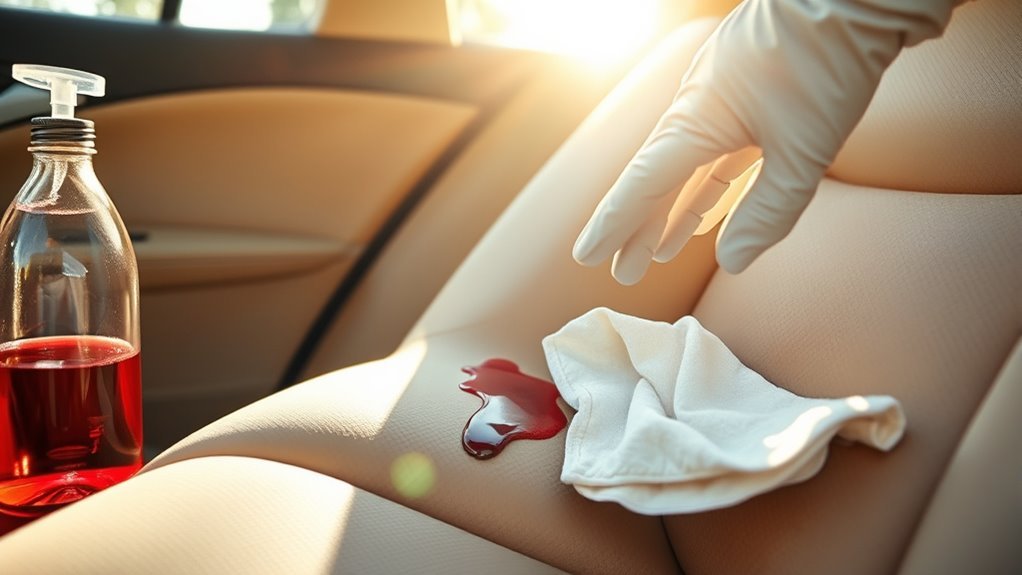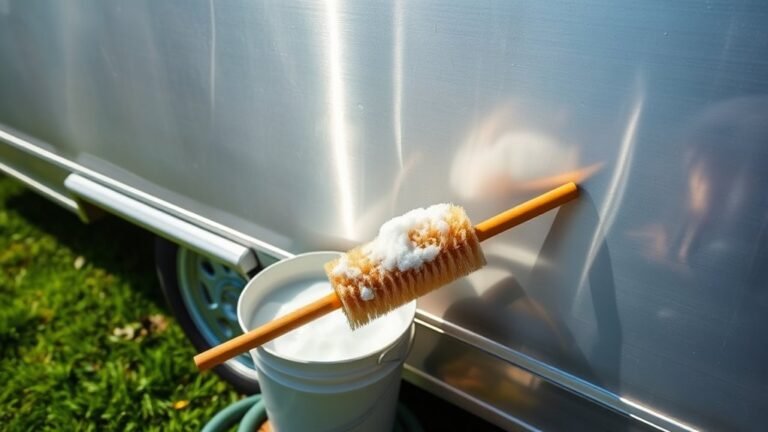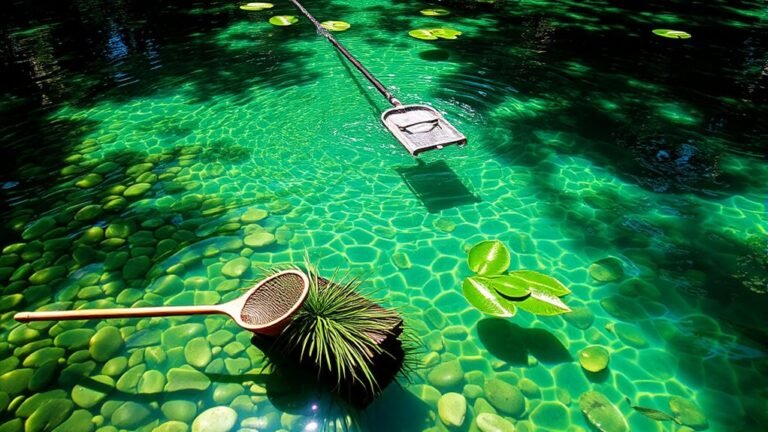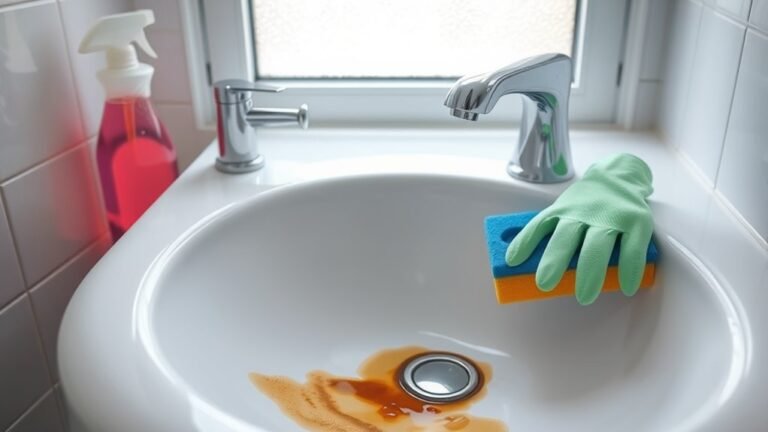How to Remove Stubborn Stains From Car
To remove stubborn stains from your car, first identify the stain type—bird droppings, tree sap, or grease—to choose the right cleaner. Use a soft microfiber cloth and pH-balanced products to avoid paint damage. For sap, gently soften with isopropyl alcohol; for grease, apply an automotive degreaser. Avoid harsh scrubbing and always rinse thoroughly. If stains persist or seem tough, it’s best to explore specialized techniques and tools to protect your vehicle’s finish effectively.
Identifying Different Types of Stains on Your Car
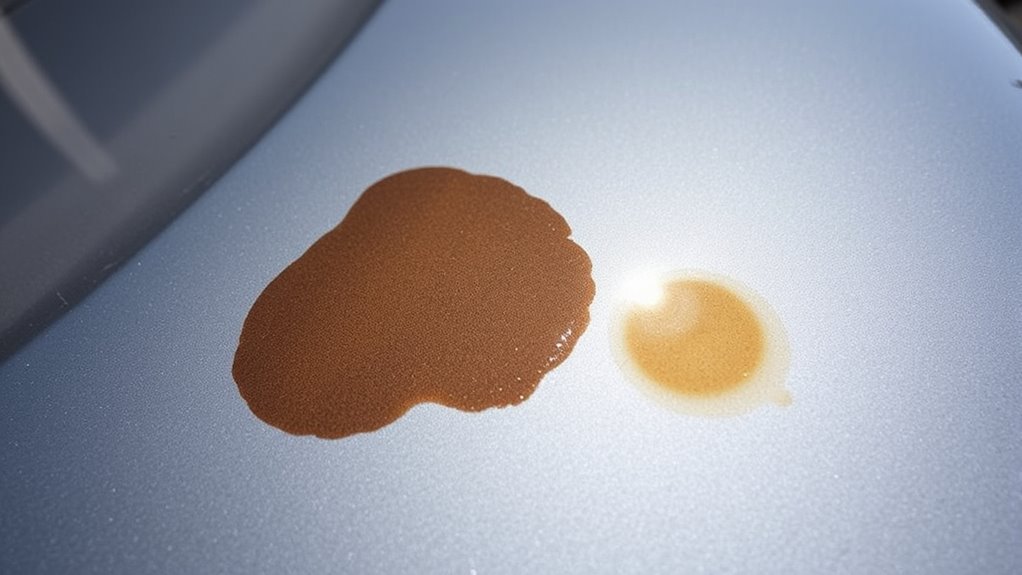
Before you can effectively remove stubborn stains from your car, you need to accurately identify the type of stain you’re dealing with. Different stain types—such as bird droppings, tree sap, road tar, or grease—require specific treatments to avoid paint damage. Bird droppings are acidic and can etch your paint if not promptly addressed. Tree sap is sticky and resinous, often needing solvents for removal. Road tar and grease are oily and may require specialized degreasers. Misidentifying stains risks worsening paint damage through improper cleaning methods. Carefully examine the stain’s texture, color, and location to classify it precisely. This step guarantees you select the right approach, preserving your car’s finish and maintaining your freedom to drive without blemish concerns. Understanding the importance of stain identification helps target cleaning efforts effectively and protects your vehicle’s surface.
Essential Tools and Products for Stain Removal
Once you’ve pinpointed the exact type of stain affecting your car, you’ll need the right tools and products to tackle it effectively without damaging your paint. Selecting appropriate cleaning supplies and a targeted stain remover is vital for precise stain elimination. Equip yourself with:
- Microfiber cloths, which reduce scratching during application and wiping.
- A pH-balanced automotive stain remover designed for your specific stain type.
- Soft-bristle brushes to gently agitate stubborn residues without harming surfaces.
Using these tools properly guarantees you maintain your car’s finish while liberating it from blemishes. Avoid harsh chemicals or abrasive materials that can compromise your paint layer. Understanding the chemistry of stains helps in choosing the most effective products for removal. With these essentials, you’ll have the freedom to clean confidently and restore your vehicle’s appearance efficiently.
Removing Bird Droppings Safely
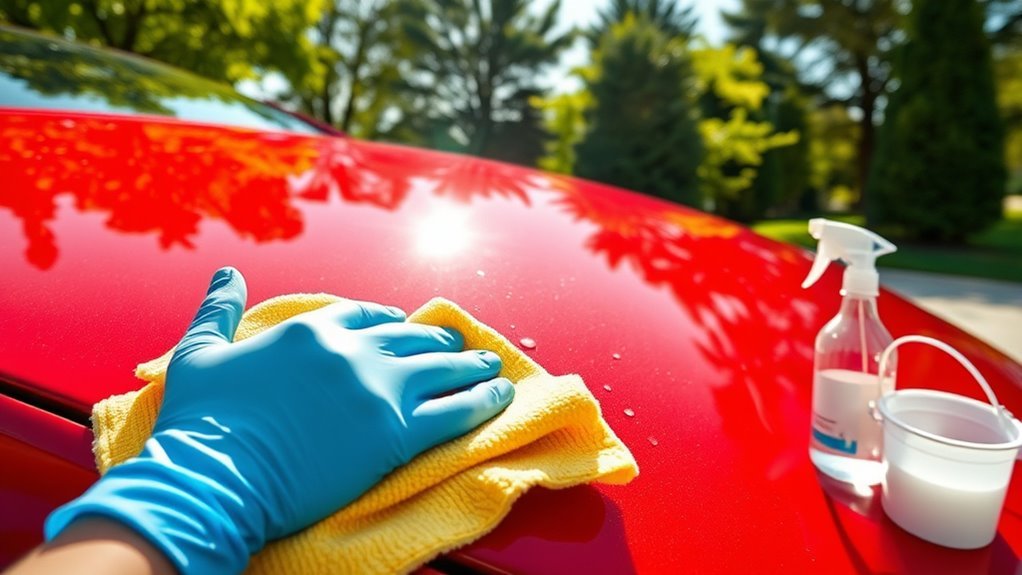
You should remove bird droppings as soon as possible to prevent paint damage caused by their acidic content. Use a soft microfiber cloth with a gentle, pH-neutral cleaner or water to lift the droppings without scratching the surface. Avoid scrubbing harshly; instead, let the cleaner sit briefly to soften the stain before wiping it away carefully. Using microfiber cloths helps prevent scratches and ensures a gentle cleaning process.
Immediate Cleaning Importance
Although bird droppings may seem harmless at first, they contain acidic compounds that can quickly damage your car’s paint if not removed promptly. An immediate response is essential to prevent stain urgency from escalating into permanent etching. When you spot fresh droppings, act swiftly to protect your vehicle’s finish.
Visualize this:
- A white, crusty patch rapidly corroding the clear coat
- Acidic residue seeping deeper into the paint layers
- Fading and discoloration emerging within hours
Safe Cleaning Methods
Because bird droppings contain acidic compounds that can damage your car’s paint, it’s essential to use safe cleaning methods that neutralize the acids without harming the finish. Begin by softening the droppings with a damp microfiber cloth soaked in water mixed with a mild, eco friendly option such as diluted white vinegar or baking soda solution. Let it sit for several minutes to loosen the residue. Avoid abrasive scrubbing, which can scratch the paint. Gently wipe away the softened droppings using vertical strokes. For stubborn spots, apply a paste of baking soda and water as a home remedy, then rinse thoroughly with clean water. Finally, dry the area promptly with a soft cloth to prevent water spots and further damage. Following these steps preserves your car’s finish while respecting your freedom to choose greener solutions.
How to Get Rid of Tree Sap Without Damaging Paint
When dealing with tree sap on your car, it’s important to act promptly to prevent the resin from hardening and bonding with the paint. For effective tree sap removal without compromising paint protection, follow these steps:
- Soften sap using isopropyl alcohol or specialized sap remover, applying gently with a microfiber cloth.
- Let the solvent sit for a minute to loosen the resin, avoiding prolonged exposure that can affect clear coat.
- Wipe sap away with light pressure, rinsing frequently to prevent residue buildup.
Always test products on a hidden area first and finish with a thorough wash and wax to restore paint protection. This method guarantees sap removal without abrasion, maintaining your vehicle’s finish while granting you freedom from stubborn stains. Prompt treatment is essential, as understanding stain origin helps tailor effective removal techniques.
Tackling Grease and Oil Stains Effectively
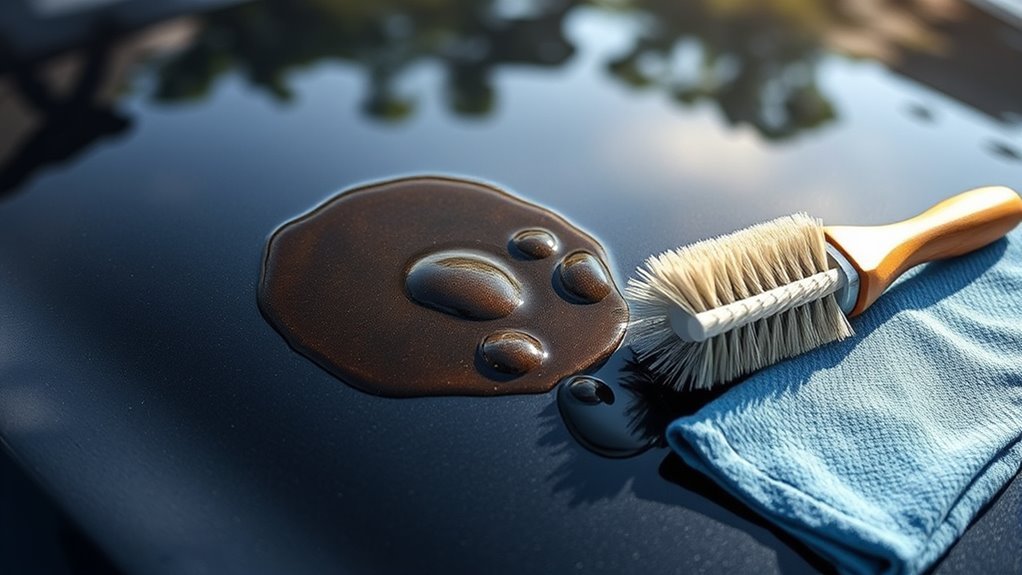
Dealing with grease and oil stains on your car requires prompt and targeted action to prevent long-term damage to the paint and surface. Start by applying a specialized degreaser designed for automotive use, ensuring it’s safe for your car’s finish. For effective grease removal, spray the affected area generously, allowing the solution to penetrate and break down the contaminants. Next, gently agitate with a soft brush or microfiber cloth to lift the stain without scratching. Rinse thoroughly with water to remove all residues. If the stain persists, repeat the oil treatment process, but avoid harsh chemicals that could strip the paint. Finally, wash and dry the area as usual. Consistent, precise grease removal is essential to maintain your vehicle’s pristine appearance and protect its freedom on the road. Using natural solutions such as vinegar and baking soda can also help minimize reliance on harsh chemicals while effectively cutting through grease.
Using Clay Bars for Deep Cleaning Stubborn Stains
Using a clay bar can effectively remove embedded contaminants that traditional washing misses, restoring a smooth surface. You’ll need to lubricate the area properly before gently gliding the clay bar to avoid scratching the paint. Follow a systematic pattern and frequently check the clay for debris to maintain ideal cleaning performance.
Benefits of Clay Bars
Although traditional washing methods can remove surface dirt, they often leave behind embedded contaminants that cause stubborn stains. Using a clay bar offers distinct clay bar benefits by physically lifting these impurities without damaging your paint. The clay bar application provides a smooth, contaminant-free surface, enhancing your car’s finish and preparing it for waxing or sealing.
When you use a clay bar, you’ll notice:
- Removal of industrial fallout, brake dust, and tree sap embedded in the paint
- Improved surface smoothness, allowing for better light reflection and shine
- Enhanced protection as sealants and waxes bond more effectively to a clean surface
Mastering clay bar use grants you the freedom to maintain your vehicle’s pristine condition with professional-level results.
Proper Clay Bar Technique
Mastering the proper clay bar technique involves a few essential steps to guarantee you remove stubborn stains effectively without harming your vehicle’s paint. First, wash and dry your car thoroughly. Lubricate the surface with a clay lubricant to enable smooth clay bar application. Gently glide the clay bar in straight lines, avoiding circular motions. Check frequently for contaminants on the clay and fold to expose a clean surface. After treating each section, wipe with a microfiber towel. The clay bar benefits include removing embedded particles and restoring smoothness, vital for deep cleaning.
| Step | Action | Tip |
|---|---|---|
| 1 | Wash & dry car | Prevents surface scratches |
| 2 | Apply lubricant | Guarantees smooth clay movement |
| 3 | Glide clay bar straight | Avoids paint swirl marks |
| 4 | Fold clay regularly | Exposes clean clay surface |
| 5 | Wipe excess lubricant | Prepares surface for polishing |
The Role of Vinegar and Baking Soda in Stain Removal
When tackling stubborn car stains, vinegar and baking soda offer a powerful chemical combination that breaks down tough residues effectively. Vinegar benefits include its acidic nature, which dissolves mineral deposits and neutralizes odors. Baking soda acts as a mild abrasive and deodorizer, lifting grime without damaging surfaces. To use:
- Sprinkle baking soda directly on the stain.
- Spray or dab white vinegar over the baking soda, causing a fizzing reaction.
- Let the mixture sit for 10 minutes, then gently scrub with a soft brush.
This approach leverages the acid-base reaction to loosen dirt, allowing you to rinse away stains with minimal effort. You gain the freedom to clean without harsh chemicals, preserving your car’s finish while restoring its appearance efficiently. Additionally, always test a small area before applying the mixture widely to ensure the surface is not damaged.
Applying Commercial Stain Removers: What to Know
Since commercial stain removers are formulated with specialized chemicals, you’ll need to understand their proper application to avoid damage and maximize effectiveness. Begin by selecting commercial stain options suited to your car’s material—fabric, leather, or plastic. Always test the remover on an inconspicuous area first to assess compatibility and prevent discoloration. Apply a small amount directly onto the stain, following manufacturer instructions precisely regarding dwell time. Avoid excessive scrubbing, which can degrade surfaces. After treatment, thoroughly rinse or wipe the area to remove chemical residues that might cause long-term damage. Monitor stain remover effectiveness closely; if the stain persists after the first application, repeat cautiously. By handling commercial stain removers with care and precision, you maintain your car’s integrity while achieving ideal stain removal results.
Preventative Measures to Avoid Future Stains
Although removing stains is essential, taking proactive steps to prevent them can save you time and preserve your car’s interior condition. Effective stain prevention starts with understanding vulnerable areas and applying protective coatings designed to repel liquids and dirt.
Proactively preventing stains preserves your car’s interior and saves time on cleaning efforts.
To maintain your car’s freedom from stains, focus on these key measures:
- Regularly apply fabric or leather protectants that form a barrier against spills.
- Use washable seat covers or floor mats to shield original surfaces.
- Implement a routine cleaning schedule to prevent dirt buildup that can cause permanent stains.
- Utilizing multi-purpose cleaners can simplify maintenance and help keep surfaces spotless while reducing costs.
When to Seek Professional Help for Persistent Stains
Even with diligent preventative measures, some stains resist removal and require expert intervention. When you encounter persistent stains that don’t respond to standard cleaning methods, it’s time to contemplate professional cleaning. A thorough stain assessment by specialists will identify the stain’s composition and determine the safest, most effective removal technique. Attempting aggressive treatments without proper knowledge risks damaging your car’s surface or interior materials. Professionals use advanced tools and chemical agents optimized for specific stains, ensuring precision without compromising your vehicle’s finish. If a stain has penetrated deeply or covers a large area, don’t hesitate to seek expert help. By opting for professional cleaning, you preserve your car’s appearance and extend its lifespan, maintaining the freedom to enjoy your vehicle without unsightly blemishes. Recognizing the types of car stains is crucial to deciding when professional cleaning is necessary.
Frequently Asked Questions
Can Household Bleach Be Used to Remove Car Stains?
You might wonder about bleach effectiveness for stain removal, but using household bleach on your car isn’t recommended. Bleach can cause discoloration and damage paint, compromising your vehicle’s finish. Instead, opt for specialized automotive stain removers designed to tackle tough stains safely without risking harm. If you value your car’s appearance and want effective stain removal, stick to products formulated specifically for automotive use rather than household bleach.
How Long Should Stain Remover Sit on the Car Surface?
For flawless finishing, fostering stain remover effectiveness hinges on the ideal application time. You should let the stain remover sit for about 5 to 10 minutes on the car surface, no longer than 15 to avoid damage. This precise period guarantees the solution penetrates stubborn stains without harming your paint. Always follow the product’s instructions for best results, and remember to rinse thoroughly to free your finish from residue.
Will Waxing My Car Remove Existing Stains?
Waxing your car won’t remove existing stains; it’s designed primarily for stain prevention and enhancing paint protection. Waxing effectiveness lies in creating a hydrophobic barrier that repels contaminants, reducing future staining. To remove current stains, you’ll need targeted cleaning methods like stain removers or polishing. After thoroughly cleaning, apply wax to maintain your car’s finish and prevent new stains, ensuring your vehicle stays free and clear of stubborn marks.
Are Natural Remedies Safer Than Chemical Stain Removers?
You’ll find natural alternatives generally safer than chemical stain removers because they contain fewer harsh substances that can damage surfaces or harm your health. Eco friendly options like vinegar, baking soda, or lemon juice effectively break down stains without toxic residues. These remedies grant you freedom from harsh chemicals, allowing precise control over cleaning while minimizing environmental impact. Always test on a small area first to ascertain compatibility with your car’s finish.
Can Stains Damage the Car’S Undercarriage or Mechanical Parts?
Imagine you ignore oil stains leaking onto your car’s undercarriage; over time, this can cause serious undercarriage damage. You’ll want to act quickly because chemicals and grime can accelerate corrosion, leading to mechanical issues like compromised brake lines or exhaust problems. To protect your freedom on the road, regularly inspect and clean these areas using appropriate cleaners, ensuring stains don’t jeopardize your vehicle’s structural integrity or performance.
